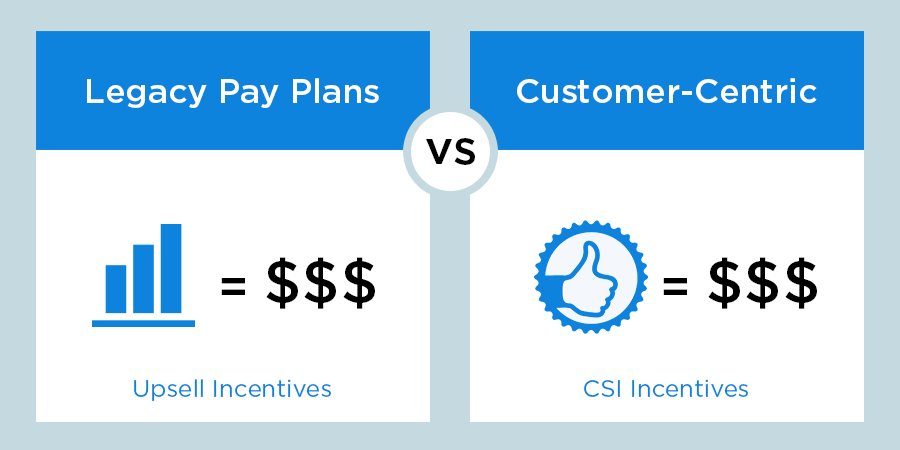How Changing Service Advisor Pay Plans Helps Employees Feel Valued
When it comes to implementing a Complimentary Maintenance Program, everyone can agree on a maintenance-included strategy that doubles the repair order count.However, issues arise with the service department because their existing legacy pay plans are heavily weighted on customer pay per repair order averages.
The legacy pay plan structure can create anxiety for the service staff because an increase in routine maintenance visits results in more .3 and .5 repair orders, which lowers the service advisor’s customer pay average per repair order and may affect their bonuses.
As a result of legacy pay plan structures, the second most common misconception we hear among auto dealerships is, “Complimentary Maintenance will complicate our exisiting service department pay plans.”
But, what if a change in service department pay plans isjust the solution you need to help employees feel valued, and in return, build better service relationships that fuel vehicle trade-in and repurchase?
The Problem with Legacy Pay Plans
Let’s take a look at an example of a legacy pay plan, which is typically a flat salary plus a CP hours per RO bonus. If you think about it, these pay plan structures are set up to treat oil changes as a penalty.
For example, if a service tech wrote one repair order for an oil change, it would be a .30 repair order, meaning the technician would get 3/10 of an hour to complete that oil change. If that same tech had a 5-hour repair order that .3 RO due to an oil change takes a high CP/RO of 5 down to a much lower CP/RO of 2.65. If a service employee were to write thirty of these .3 repair orders a day, it kind of erodes a legacy pay plan and this is why service staff see oil changes as a pay cut rather than an opportunity.
It’s no wonder dealers receive so much push back when it comes to implementation of a Complimentary Maintenance Plan.
Negative Effects on Customer Experience
Unless management is open to changing their service pay plans, they won’t be very successful in making their service employees feel valued. And the cycle doesn’t end there. If your service staff has an attitude and grief toward oil changes, think of how that will negatively affect your customers returning to receive their complimentary oil changes.
Initially customersmay be impressed, appreciative and thankful that your dealership is nice enough to provide two years of maintenance coverage. However, if that customer comes in to redeem their oil changes and is greeted by a service advisor who can barely smile at the customer because he’s concerned about eroding his pay plan then it’s a bad experience for both parties. In this situation, a Complimentary Maintenance Program will not be effective because it’s no longer working as a customer retention programas it’s intended to.
Shifting Service Incentives to Promote Retention
So, how can you change your service department’s mindset to make win-win experiences for your employees and your customers?
Let’s think of service pay plans for oil changes in a different manner.
If the goalof a Complimentary Maintenance Program is to improve the Net Promoter Score at the dealership and utilize positive service experiences to sell the next vehicle, wouldn’t it make sense to align service pay plan values so that incentives are provided for positive CSI and higher Net Promoter Scores?
One solution to improving pay plans is to provide a slightly higher monthly salary so service staff and service advisors won’t feel abused by these .3 repair orders. This also shifts the focus to gross service sales instead of net service sales, which, as long as you balance your gross and net profits, ends up the same at the end of the day.
The goal of service pay plans should be to drive service staff behavior towards building more customer-centric relationships.Every dealership is unique, but we’ve outlined an example below of a before and after approach that drives customer-centric behavior.

As you can see from the example above, this new Customer-Centric Service Pay Planis shifting the focus from upsell incentives to CSI incentives. By providing incentives and bonuses based on happy customers rather than on duration of services, you can create a paradigm shift in service staff so they see oil changes as an opportunity, rather than a pay cut. This win-win solution will help both employees and customers to build better relationships, which lead to more repeat vehicle sales.
Get The Results You Want
Ask yourself, “Am Igetting the results Iwant today from my currentpay plan?”
Eight out of ten dealerships we talk to answer no to this question. We understand that it’s easier to overlook theissue, stick with your existing service pay plan and continue tellingyour servicestaff, “It’ll be good for you in the long-run, just do the oil changes and don’t worry about it.” But, essentially, that’s just bulldozing the project. We tell these dealers that doing nothing leads to nothing. If you keep doing the same old thing, you’ll get the same old results.
It may be a little painful to revamp your service pay plans, but it will be worth it. Sure, there will be work involved. You’ll have to sit down and reevaluate pay plans for service managers, shop foremen and service advisors, and you won’t be able to please every employee. You might even have someone quit, but what’s your ultimate goal? Are you in this for the long run? Do you want to improve your CSI and ensure your customers purchase a second vehicle? If so, it’s worth the training and changes involved.
If you want to grow your dealership retention then you have to have a plan you can execute on — and this is the place to start. Book time to discuss your strategy with a customer retention executive or learn how you can get your team on board with a Complimentary Maintenance Program.

